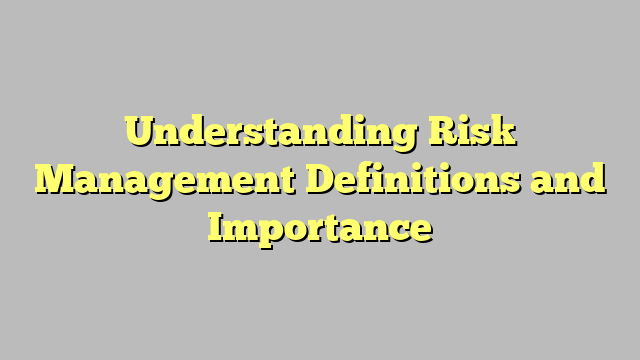Understanding Risk Management Definitions and Importance
Risk management is an essential practice across various sectors, encompassing a range of processes aimed at identifying, assessing, and mitigating potential risks that could adversely impact an organization’s objectives. By employing effective risk management strategies, businesses can protect their assets, ensure compliance, and maintain a competitive edge in an ever-changing environment. This article will explore the fundamental principles of risk management, the importance of these strategies in business and finance, and how they can be implemented effectively in project management.
Understanding Risk Management: Definitions and Importance
At its core, risk management involves recognizing potential threats and determining the best ways to reduce or eliminate their impact. This process is crucial not only for safeguarding financial resources but also for preserving an organization’s reputation and ensuring the continuity of operations. The significance of risk management transcends industries, as it provides a structured approach to decision-making that helps organizations navigate uncertainties and achieve their goals.
Common Risk Management Strategies in Business and Finance
Organizations employ various strategies for managing risk, which can be broadly categorized into qualitative and quantitative methods. Each approach has its strengths and applications depending on the specific context of the risk encountered.
Qualitative Risk Management Strategies
Qualitative methods focus on the subjective assessment of risks based on experience and judgment. Techniques such as brainstorming sessions, expert interviews, and focus groups can help identify potential risks and their potential impacts. For instance, a company might gather feedback from employees about operational challenges, leading to the identification of risks that could affect productivity. This strategy emphasizes understanding the context of the risks and allows organizations to prioritize them based on their likelihood and potential consequences.
Quantitative Risk Management Strategies
In contrast, quantitative methods involve numerical analysis and statistical techniques to evaluate risks. These strategies often rely on historical data and modeling to predict the likelihood of risks occurring and their potential impacts. For example, financial institutions frequently use quantitative analysis to assess credit risk by analyzing borrowers’ credit histories and economic conditions. This approach allows organizations to make informed decisions based on measurable data, ensuring a more objective evaluation of risks.
Risk Avoidance, Transfer, and Reduction
Three key strategies for managing risk include risk avoidance, transfer, and reduction:
- Risk Avoidance: This strategy involves eliminating activities that expose the organization to risk. For example, a company may decide against entering a high-risk market to avoid potential losses.
- Risk Transfer: Organizations can transfer risk to third parties, such as through insurance policies. For instance, technology firms may utilize specialized business insurance to mitigate financial losses from data breaches or liability claims, ensuring that any potential financial setbacks are managed effectively.
- Risk Reduction: This approach focuses on implementing measures to minimize the impact of risks. For example, a manufacturing company might invest in safety training for employees to reduce the likelihood of workplace accidents.
Implementing Risk Management Strategies in Project Management
Effective risk management is crucial in project management, where uncertainties can significantly impact timelines, budgets, and deliverables. To implement risk management strategies successfully, project managers should follow these best practices:
- Conduct Comprehensive Risk Assessments: Begin by identifying potential risks specific to the project and assessing their impact and likelihood. This systematic approach allows for better planning and resource allocation.
- Develop a Risk Management Plan: Create a plan that outlines the strategies for managing identified risks, including risk avoidance, transfer, or reduction methods.
- Engage Stakeholders: Involve team members and stakeholders in the risk management process to ensure a broad perspective on potential risks and collective ownership of the mitigation strategies.
- Monitor and Adapt: Continuously monitor risks throughout the project lifecycle and adapt strategies as necessary. This dynamic approach ensures that risk management remains effective in response to changing circumstances.
Conclusion
In conclusion, effective risk management strategies are vital for organizations aiming to navigate uncertainties and protect their interests. By understanding the various approaches to risk management, such as qualitative and quantitative methods, and applying specific strategies like risk avoidance, transfer, and reduction, businesses can create a robust framework for identifying and mitigating risks. Continuous monitoring and adaptation are essential components of this framework, ensuring that organizations remain resilient in the face of challenges and can achieve their objectives effectively.
